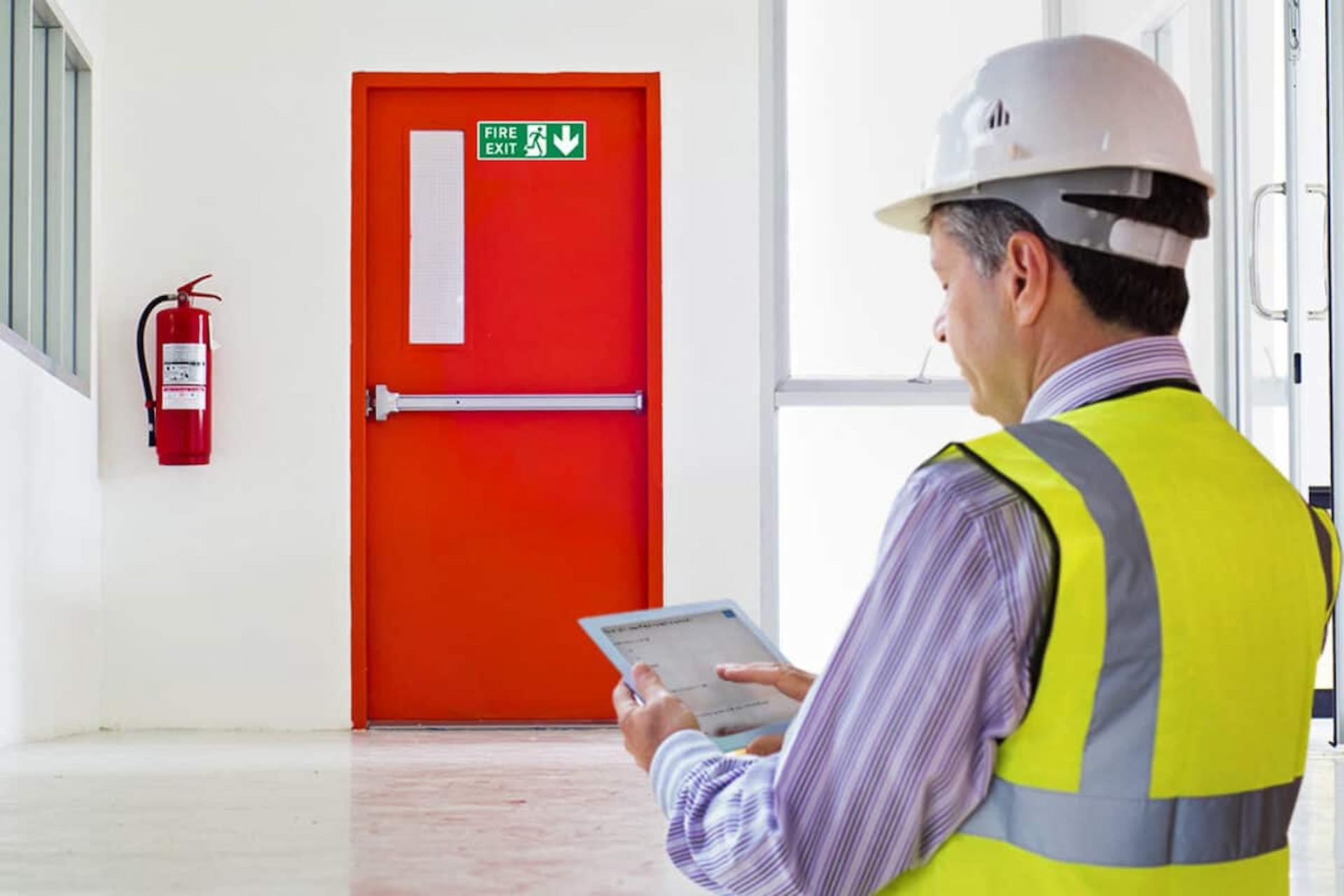A fire door inspection is a critical barrier designed to save lives and protect property. But how can you be certain yours will perform when it matters most? Regular inspections aren’t just a recommendation; they’re a legal requirement in the UK, ensuring your premises meet safety standards and comply with fire regulations.
Neglecting fire door inspections could leave you exposed to hefty fines, insurance issues, or worse—endangering lives. By investing in professional fire door inspection services, you’re not only staying compliant but also safeguarding everyone who steps through your doors. It’s about more than ticking boxes; it’s about real, tangible safety.
Importance Of Fire Door Inspection Services
Fire door inspection services ensure that fire doors perform their vital role in containing fires and protecting lives. Regular evaluations identify weaknesses, secure legal compliance, and uphold safety standards for your building.
Role In Legal Compliance
Compliance with UK fire safety regulations regarding fire doors is mandatory. The Regulatory Reform (Fire Safety) Order 2005 specifies that suitable measures, including maintenance and inspection of fire doors, must be taken to minimise risks. You might also face fines or legal action if inspections are neglected following a fire incident. Detailed reports from professional inspections confirm adherence to these laws, reducing liabilities and demonstrating diligence.
Ensuring Safety Standards
Fire door inspections verify that doors operate as intended during emergencies. Any issues like damaged seals, misaligned hinges, or warped frames reduce the containment function and endanger occupants. Regular inspections can address such problems early, ensuring doors meet safety benchmarks. The process reinforces your building’s readiness, improving occupant trust and maintaining safe evacuation routes.
Key Features Of Reliable Fire Door Inspection Services
Reliable fire door inspection services play a critical role in ensuring safety and meeting legal requirements. Exploring key features helps you understand how such services uphold compliance and protect lives.
Professional Expertise
Inspectors conducting fire door assessments bring extensive knowledge of fire safety standards. They examine physical components like seals and hinges, considering their alignment with BS 9999 and other UK standards. Expertise ensures even minor faults compromising performance are identified. Certified inspectors also provide tailored advice on maintaining compliance, reducing risks, and enhancing safety measures for your premises.
Detailed Reporting And Documentation
Accurate records of fire door inspections are essential for compliance. Reports trace findings in detail, addressing non-compliance areas such as damaged frames or inadequate intumescent strips. Documentation strengthens legal defence in case of incidents, serving as tangible proof of compliance with the Regulatory Reform (Fire Safety) Order 2005. These reports often offer prioritised recommendations, streamlining repair or replacement processes.
Use Of Advanced Tools And Techniques
Inspections rely on modern methods to improve accuracy. Tools like gap gauges measure fire door clearances, while thermal imaging can detect internal inconsistencies. Precision ensures inspections reveal hidden defects, giving you a clear understanding of the door’s condition. Leveraging advanced techniques accelerates the process, with technology improving the efficiency of assessments and boosting reliability in preparation for emergencies.
Legal Requirements For Fire Door Compliance
Maintaining fire door compliance is a critical step in meeting legal standards and ensuring safety. UK legislation establishes clear expectations, placing responsibility on property owners and managers.
Regulatory Guidelines
The Regulatory Reform (Fire Safety) Order 2005 outlines your duty to ensure fire doors meet specific standards. These doors, as part of passive fire protection systems, should prevent fire and smoke spread. Regular inspections must confirm proper installation, functioning seals, and aligned frames. BS 9999 provides guidance on identifying non-compliance, aligning fire doors with safety benchmarks. Inspections can assess wear-driven issues like warping or damaged intumescent strips. Reports from qualified professionals are valuable as evidence of adherence to these laws during safety reviews.
Consequences Of Non-Compliance
Failing legal obligations might lead to significant penalties. Fines for non-compliance can range from several thousand pounds to more than £50,000. Investigations following a fire may uncover faults in fire doors, potentially resulting in liability claims or imprisonment for gross negligence. Non-compliance tarnishes relationships with insurers, allowing claims to be declined after incidents. Beyond financial impacts, dysfunctioning doors compromise evacuation routes, increasing risks for occupants. Fire incidents often expose lack of preparation, eroding trust in building safety standards. Being proactive prevents legal troubles and ensures accountability for public and employee safety.
Benefits Of Regular Fire Door Inspections
Fire door inspections serve as a key strategy in supporting safety measures and maintaining compliance within your building. They provide tangible benefits that protect lives, uphold legal standards, and minimise risks.
Prevention Of Fire Hazards
Regular inspections help reduce fire risks by identifying vulnerabilities that might otherwise go unnoticed. Flaws such as gaps around the door, damaged seals, or warped frames can compromise fire containment. Early detection allows you to address these issues promptly, minimising dangers to occupants. Inspections also ensure the integrity of installed hardware like hinges and latches, confirming their ability to withstand high temperatures and prevent fire spread. Without consistent checks, problems can escalate, leading to higher safety risks within the property.
Enhanced Building Safety
Routine inspections strengthen the safety framework of your building, ensuring fire doors perform effectively during emergencies. Fire doors act as barriers, delaying the speed at which flames and smoke travel. Inspections verify alignment, closure mechanisms, and structural integrity, maintaining their reliability. When fire doors function properly, they secure evacuation routes, providing critical time for people to escape. This consistency elevates overall occupant protection, demonstrating a commitment to safety that builds trust and reassurance among those using the space.
Long-Term Cost Savings
Scheduled inspections reduce long-term costs by preventing extensive damage and costly repairs. Addressing minor issues, such as loosening handles or deteriorating seals, avoids the need for full replacements over time. Functional fire doors also support insurance claim approvals in case of incidents, protecting you from legal and financial repercussions. Additionally, meeting regulatory compliance reduces the likelihood of fines and liability issues, saving expenses that might arise from negligence or non-conformance. Proactively maintaining fire doors ensures both economic and safety benefits for your building.
How To Choose The Right Fire Door Inspection Service Provider
Selecting a reliable fire door inspection service is vital for maintaining safety and meeting legal standards. Evaluating providers based on specific criteria ensures you make an informed choice.
Factors To Consider
Evaluate the provider’s qualifications to ensure inspectors are certified under recognised schemes like FIRAS or BM TRADA. Expertise in UK fire safety standards, including the Regulatory Reform (Fire Safety) Order 2005, distinguishes dependable professionals. Examine the provider’s track record by reviewing testimonials or case studies that reflect their experience with similar properties. Check whether their services include comprehensive reporting since documented assessments prove compliance and highlight actionable defects. Determine if they utilise modern inspection technologies to uncover concealed wear or misalignments that could evade detection.
Questions To Ask
How often do their inspections align with recommendations, such as monthly, quarterly, or annual checks? Do they assess all components from door closers to intumescent seals? Clarify if they provide a detailed checklist or report post-inspection to summarise findings. Ask about repair solutions or referrals if issues are detected during the assessment. Do their services comply with standards like BS 9999, ensuring adherence to UK guidelines? Finally, confirm their insurance coverage for added security in case unexpected problems arise post-inspection.
In Closing
Fire door inspection services are a vital component of maintaining safety and ensuring legal compliance in your building. By prioritising regular inspections, you protect lives, reduce liabilities, and uphold your responsibilities under UK fire safety regulations.
Choosing a professional and reliable inspection provider ensures your fire doors function as intended during emergencies. This proactive approach not only safeguards occupants but also reinforces trust and demonstrates your commitment to safety.

